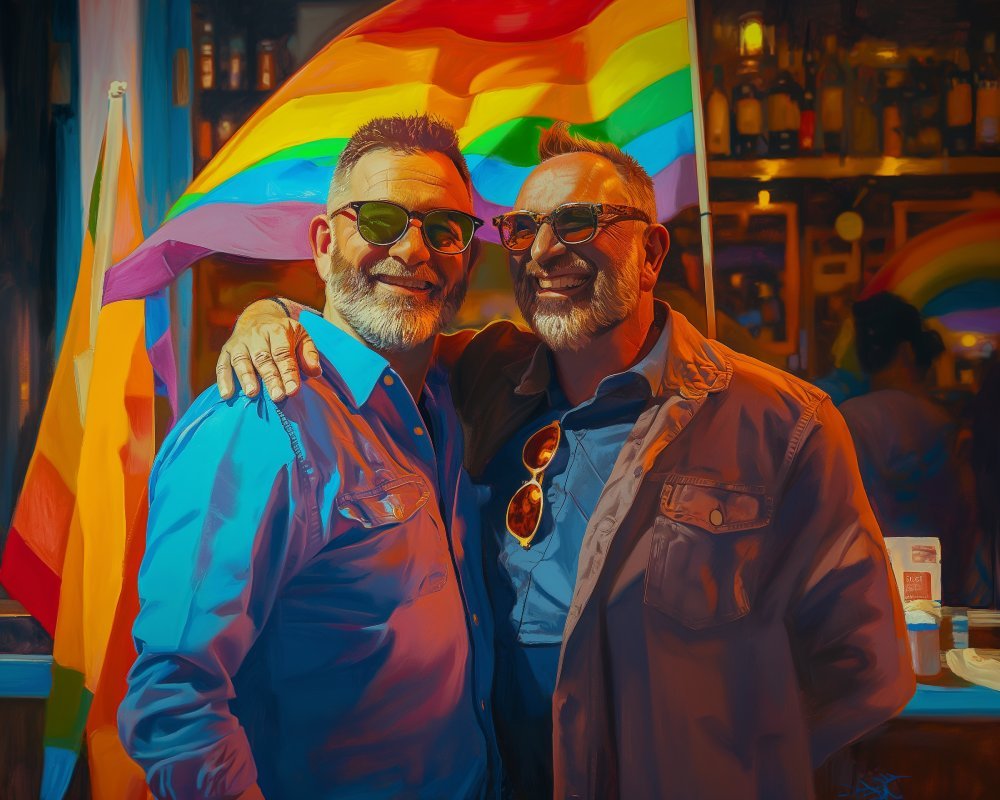
A Deep Dive into Its Origins, Practices, and Harmful Impact – What Is Gay Conversion Therapy?
What is Gay Conversion Therapy? Also known as “reparative therapy” or “sexual orientation change efforts” (SOCE), gay conversion therapy refers to the pseudoscientific practice of attempting to change an individual’s sexual orientation from homosexual or bisexual to heterosexual. It is based on the false assumption that being gay or bisexual is a disorder that can be “cured” or “fixed.” Despite being discredited by nearly all major medical and psychological organizations, gay conversion therapy continues to be practiced in various parts of the world, often targeting vulnerable LGBTQ+ individuals.
In this blog, we’ll explore what is gay conversion therapy, its historical roots, the specific techniques used, and its harmful effects. We will also highlight the global response to gay conversion therapy, the legal measures being taken to ban it, and the personal stories of individuals who have been subjected to this damaging practice.
What Is Gay Conversion Therapy? The History and Origins
To truly understand what is gay conversion therapy, we need to look at its origins. The practice can be traced back to the early 20th century, at a time when homosexuality was widely considered a mental illness or moral failing. Early proponents of gay conversion therapy often came from religious or psychiatric backgrounds, driven by the belief that same-sex attraction was abnormal and needed to be corrected.
One of the first significant figures in this movement was Sigmund Freud, who believed that homosexuality was a developmental issue. However, Freud’s later works indicated that he did not believe it could be “cured.” Despite this, others in the psychological and psychiatric fields seized upon his early writings to develop various techniques aimed at “converting” people from gay to straight.
The movement gained momentum during the mid-20th century, particularly in the United States, as evangelical Christian groups became involved. These groups argued that homosexuality was sinful and could be changed through faith-based practices. This is where the practice began to take on both religious and psychological dimensions, leading to various forms of gay conversion therapy being offered by religious ministries, as well as licensed therapists.

What Is Gay Conversion Therapy? The Techniques Used
What is gay conversion therapy when it comes to the actual methods and techniques involved? Over the years, a range of techniques has been employed, some of which are disturbingly abusive and harmful. These methods are designed to repress or eliminate same-sex attractions, but they have been widely discredited by medical professionals due to their inefficacy and harmful nature.
Here are some of the common techniques used in gay conversion therapy:
- Talk Therapy: This involves prolonged counseling sessions where individuals are encouraged to “uncover” supposed reasons for their same-sex attraction, such as childhood trauma, poor parental relationships, or abuse. The goal is to convince the person that their attraction to the same sex is a result of unresolved emotional issues that can be “fixed.”
- Aversion Therapy: One of the most infamous techniques used in gay conversion therapy, aversion therapy involves exposing individuals to images or videos of same-sex couples and then administering electric shocks or nausea-inducing drugs in an attempt to associate same-sex attraction with negative physical sensations.
- Behavioral Therapy: Behavioral modification techniques, such as enforcing strict gender roles or promoting opposite-sex relationships, are often used to “train” individuals to become heterosexual. These practices are often paired with reward and punishment systems that reinforce heterosexual behaviors and discourage same-sex attraction.
- Exorcisms and Religious Rituals: In faith-based gay conversion therapy, participants may be subjected to exorcisms, prayer sessions, or other religious rituals aimed at “casting out” the supposed demons or spirits causing same-sex attraction.
- Hormonal Treatments: In extreme cases, individuals have been prescribed hormone treatments or medications to suppress sexual desire altogether. These treatments are not only ineffective but can also cause significant physical and psychological harm.
While these are just a few examples of the techniques used, what is gay conversion therapy at its core is a coercive and harmful process that attempts to change an inherent aspect of a person’s identity.
Recommended
The Harmful Effects of Gay Conversion Therapy
The question, what is gay conversion therapy, cannot be answered without acknowledging its devastating impact on individuals who are subjected to it. Decades of research have shown that not only is gay conversion therapy ineffective, but it also leads to severe psychological, emotional, and even physical harm.
Here are some of the documented effects of gay conversion therapy:
- Increased Risk of Mental Health Issues: Studies have found that individuals who undergo gay conversion therapy are at a higher risk of developing anxiety, depression, and other mental health issues. Many individuals who have gone through conversion therapy experience long-lasting trauma that affects their mental well-being for years.
- Suicidal Ideation and Self-Harm: LGBTQ+ individuals who have been subjected to conversion therapy are significantly more likely to experience suicidal thoughts and attempts. The rejection of their identity and the intense psychological pressure to conform to heterosexual norms can lead to feelings of hopelessness and self-hatred.
- Damage to Self-Esteem and Identity: One of the most insidious aspects of gay conversion therapy is its ability to destroy a person’s self-esteem and sense of identity. By framing same-sex attraction as something that needs to be “fixed,” individuals are often left feeling ashamed of who they are.
- Estrangement from Family and Community: Many individuals who undergo gay conversion therapy are pressured into doing so by family members or religious leaders. This can lead to strained relationships with loved ones and a sense of isolation, particularly if the individual later rejects conversion therapy and chooses to embrace their LGBTQ+ identity.
- Loss of Faith: For those who are subjected to religious-based conversion therapy, the experience can lead to a loss of faith or a deep distrust of religious institutions. This can be particularly painful for individuals who have a strong spiritual or religious identity.

Global Response: Efforts to Ban Gay Conversion Therapy
As awareness of the harmful effects of gay conversion therapy has grown, efforts to ban the practice have gained traction around the world. But what is gay conversion therapy’s status in terms of legal and political action?
In recent years, several countries and states have taken legal measures to ban or restrict the practice of gay conversion therapy, particularly for minors. Here are some notable examples:
- United States: In the U.S., gay conversion therapy is not banned at the federal level, but many states and local jurisdictions have enacted laws prohibiting the practice, particularly for minors. As of 2021, 20 states, including California, New York, and Illinois, have passed laws banning conversion therapy for minors. Several cities and counties in other states have also enacted bans.
- Canada: In 2021, Canada introduced federal legislation to ban gay conversion therapy for both minors and adults. This legislation aims to criminalize practices that seek to change an individual’s sexual orientation or gender identity.
- Germany: Germany became one of the first major European countries to ban gay conversion therapy for minors in 2020. The law prohibits advertising, offering, or performing conversion therapy on individuals under the age of 18.
- United Kingdom: The U.K. government has committed to banning gay conversion therapy, though as of 2021, the legislation has not yet been passed. LGBTQ+ advocacy groups continue to push for a comprehensive ban that would protect individuals of all ages.
- Brazil: Brazil has one of the earliest and most comprehensive bans on gay conversion therapy, having outlawed the practice as early as 1999. The ban was imposed by the country’s Federal Council of Psychology.
Despite these efforts, gay conversion therapy remains legal in many parts of the world, particularly in countries with strong religious or conservative influence. Activists and advocacy groups continue to fight for comprehensive bans, arguing that what is gay conversion therapy is a clear violation of human rights.
Personal Stories: Survivors of Gay Conversion Therapy
While statistics and research provide important insights into the harms of gay conversion therapy, the personal stories of those who have experienced it offer a deeper understanding of what is gay conversion therapy from a human perspective.
Many survivors of gay conversion therapy describe feelings of shame, confusion, and trauma that continue to impact their lives long after the therapy sessions have ended. For some, the experience led to years of struggling with their sexual orientation, while others found the courage to reject the therapy and embrace their true selves.
One survivor, Samuel Brinton, has become an outspoken advocate against gay conversion therapy. After enduring years of conversion therapy as a teenager, Brinton now works with advocacy groups to ban the practice in the United States. Brinton has shared their story widely, detailing the emotional and psychological toll that conversion therapy took on them, including the pressure to conform to heterosexual norms and the trauma of undergoing aversion therapy.
Another survivor, Mathew Shurka, spent five years in conversion therapy, during which he was told that his same-sex attractions were the result of a poor relationship with his father. Shurka has since become an activist, advocating for legislation to ban the practice and raising awareness about the harm it causes.
These personal stories are a powerful reminder of the real-life consequences of what is gay conversion therapy and why it is so important to continue fighting for its eradication.

Recommended
The Future: Eradicating Gay Conversion Therapy
Looking ahead, what is the future of gay conversion therapy? As more research emerges and more survivors share their stories, the global movement to end gay conversion therapy is gaining momentum. Advocacy groups, medical professionals, and lawmakers are increasingly recognizing the need to protect LGBTQ+ individuals from this harmful practice.
However, the fight is far from over. In many parts of the world, gay conversion therapy continues to be practiced, often under the radar and with little legal oversight. Religious organizations, in particular, remain some of the most vocal proponents of the practice, arguing that it is a matter of religious freedom.
The ultimate goal of LGBTQ+ activists and advocates is to see gay conversion therapy banned worldwide. This will require continued education, advocacy, and legislative action to ensure that future generations of LGBTQ+ individuals are not subjected to this harmful and discredited practice.
Interesting Facts About Gay Conversion Therapy
- Discredited by Major Organizations: All major medical and psychological organizations, including the American Medical Association and the American Psychological Association, have discredited gay conversion therapy as both ineffective and harmful.
- First Ban in Brazil: Brazil was one of the first countries to ban gay conversion therapy, outlawing the practice in 1999.
- Conversion Therapy for Children: Many of the individuals who undergo gay conversion therapy are minors, often coerced into the practice by their parents or religious leaders.
- Increased Risk of Suicide: Studies have shown that LGBTQ+ individuals who undergo gay conversion therapy are more likely to experience suicidal thoughts and behaviors.
- Global Advocacy: International organizations such as the United Nations have called for a global ban on conversion therapy, describing it as a violation of human rights.
- Medical Harm: Some forms of gay conversion therapy, such as aversion therapy and hormone treatments, can cause significant physical harm in addition to psychological damage.
- Faith-Based Movements: Many proponents of gay conversion therapy come from religious organizations that view homosexuality as immoral or sinful.
- Celebrity Advocates: High-profile figures, such as Ellen Page and Tim Cook, have spoken out against gay conversion therapy and advocated for its ban.
- Survivor Advocacy: Many survivors of gay conversion therapy, like Samuel Brinton and Mathew Shurka, have become leading voices in the movement to ban the practice.
- Hidden Practices: In countries where conversion therapy is banned, some practitioners continue to offer the service covertly or under different names.
- Psychological Techniques: Conversion therapy often relies on outdated psychological techniques that have been discredited by modern science.
- Non-Heterosexual Relationships: Conversion therapy is not limited to “gay” conversion but also targets individuals who are bisexual or otherwise non-heterosexual.

FAQs About What Is Gay Conversion Therapy?
1. What is gay conversion therapy?
Gay conversion therapy is a discredited practice aimed at changing an individual’s sexual orientation from homosexual or bisexual to heterosexual.
2. Why is gay conversion therapy harmful?
Gay conversion therapy is harmful because it can lead to severe psychological, emotional, and even physical damage, including depression, anxiety, and suicidal thoughts.
3. What are some techniques used in gay conversion therapy?
Techniques include talk therapy, aversion therapy, behavioral modification, religious rituals, and, in extreme cases, hormonal treatments.
4. Is gay conversion therapy legal?
Gay conversion therapy is illegal in some countries and regions, particularly for minors. However, it remains legal and practiced in many areas.
5. Why do people undergo gay conversion therapy?
Many individuals are pressured into gay conversion therapy by family members, religious leaders, or societal expectations.

6. What are the long-term effects of gay conversion therapy?
Long-term effects include trauma, loss of self-esteem, mental health issues, and strained relationships with family and community.
7. How can gay conversion therapy affect LGBTQ+ youth?
LGBTQ+ youth subjected to gay conversion therapy are at a higher risk of mental health issues, including depression, anxiety, and suicidal thoughts.
8. Is there scientific evidence supporting gay conversion therapy?
No, gay conversion therapy has been discredited by major medical organizations and is considered ineffective and harmful.
9. Can adults be forced into gay conversion therapy?
While it is more common for minors to be coerced into conversion therapy, adults can also face pressure from family, religious communities, or societal expectations.
10. What is the role of religious groups in promoting gay conversion therapy?
Religious groups have historically been some of the strongest proponents of gay conversion therapy, viewing homosexuality as sinful and believing it can be “cured.”
11. Is gay conversion therapy banned worldwide?
Gay conversion therapy is not banned worldwide, though several countries and regions have passed laws prohibiting it, especially for minors.

12. Are there alternative names for gay conversion therapy?
Yes, other terms include “reparative therapy” and “sexual orientation change efforts” (SOCE).
13. What is the future of gay conversion therapy?
The future of gay conversion therapy is uncertain, but global efforts are underway to ban the practice entirely and protect LGBTQ+ individuals from its harmful effects.
14. What is the role of survivors in banning gay conversion therapy?
Many survivors of gay conversion therapy have become advocates for banning the practice, sharing their personal stories and raising awareness about its harms.
15. How does gay conversion therapy impact family relationships?
Gay conversion therapy can cause strain in family relationships, particularly if the individual rejects the therapy and embraces their LGBTQ+ identity.
16. Can gay conversion therapy lead to loss of faith?
For some individuals, gay conversion therapy can lead to a loss of faith or a deep distrust of religious institutions.
17. Are there laws protecting minors from gay conversion therapy?
In many countries and states, laws specifically protect minors from being subjected to gay conversion therapy.

18. What organizations are working to ban gay conversion therapy?
Many advocacy groups, such as The Trevor Project and the Human Rights Campaign, are actively working to ban gay conversion therapy worldwide.
19. How can individuals help end gay conversion therapy?
Individuals can help by supporting advocacy groups, raising awareness about the harm of conversion therapy, and pushing for legal action in their communities.
20. What is the psychological impact of aversion therapy in gay conversion therapy?
Aversion therapy can lead to significant psychological trauma, including feelings of shame, self-hatred, and fear.
21. What role do medical professionals play in the fight against gay conversion therapy?
Medical professionals have played a critical role in discrediting gay conversion therapy and advocating for its ban, citing the harm it causes to mental health.
22. How has the LGBTQ+ community responded to gay conversion therapy?
The LGBTQ+ community has strongly opposed gay conversion therapy, advocating for its complete eradication and supporting survivors of the practice.
23. How does gay conversion therapy differ from traditional therapy?
Unlike traditional therapy, which seeks to affirm a person’s identity and improve mental health, gay conversion therapy aims to change an individual’s sexual orientation, often causing harm.

24. Can gay conversion therapy be considered a human rights violation?
Yes, many international organizations, including the United Nations, have classified gay conversion therapy as a violation of human rights due to the harm it inflicts on LGBTQ+ individuals.

More Recommended
The Power of Gay Representation in the Arts
The Power of Gay Representation in the Arts – Representation matters. In the LGBTQ+ community, [...]
Targeting Equality: How Brands are Catering to Lesbian Consumers in Retail
Retailers have long been aware of the power of targeted marketing when it comes to [...]
Breaking Barriers: How Gay-Owned Businesses are Reshaping the Marketing Landscape
Breaking Barriers: How Gay-Owned Businesses are Reshaping the Marketing Landscape In today’s ever-evolving marketing landscape, [...]
Navigating the Gay Dating Scene
Navigating the Gay Dating Scene – Dating in the LGBTQ+ community can be a unique [...]
Building Brand Loyalty: The Power of Diversity and Inclusion in Gay-Owned Businesses
Building Brand Loyalty: The Power of Diversity and Inclusion in Gay-Owned Businesses – “Building Brand [...]
From the Margins to the Mainstream: the Success of Lesbian-Owned Brands in Marketing
“From the Shadows to the Spotlight: How Lesbian-Owned Brands are Making Their Mark in Marketing” [...]
Pride Month Marketing Strategies for Gay-Owned Businesses
Beyond Pride Month: Celebrating and Supporting Gay-Owned Businesses Through Strategic Marketing As Pride Month comes [...]
Out and Proud: Lesbian-Owned Brands Making Waves in Marketing
to “Redefining Marketing: Lesbian-Owned Brands Leading the Way in LGBTQ+ Advertising” for better SEO optimization. [...]
Connecting with LGBTQ+ Audiences as a Gay-Owned Business
Connecting with LGBTQ+ Audiences as a Gay-Owned Business – As a gay-owned business, connecting with [...]